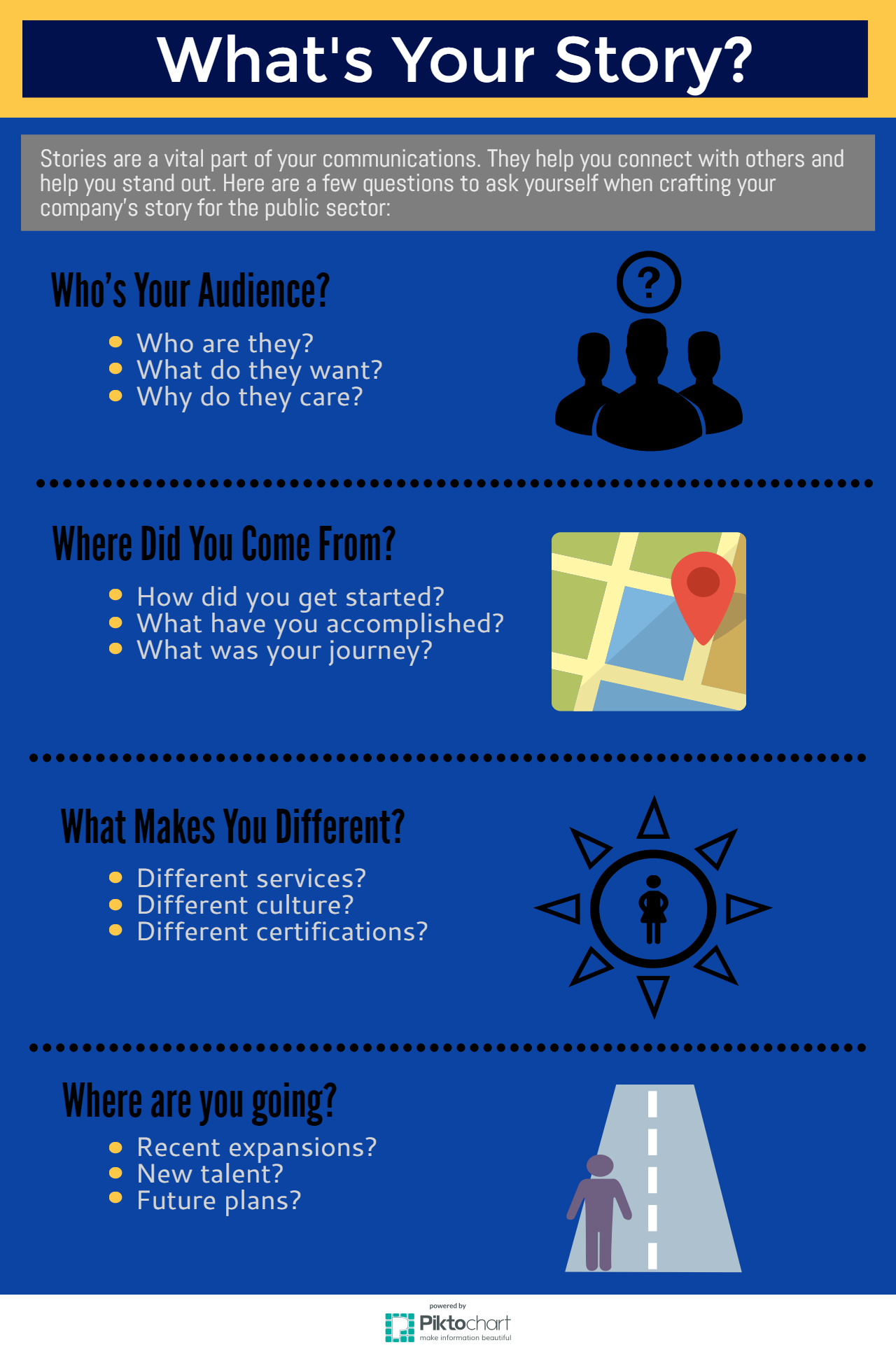What’s Your Story?

 Stories unite us.
Stories unite us.
Before the advent of writing, we scribbled drawings on rocks and cave walls and told tales to one another.
There’s a reason storytelling has continued over time. There’s a reason stories have been passed down from generation to generation. Stories accomplish many things. They entertain us, spur thinking, teach lessons, share emotions, pass knowledge.
It’s no different in the business world.
In fact, a good story creates something very meaningful: it connects you with others. It distinguishes who you are.
That’s why it’s important to take the time to identify your own story and share it, whether you’re an employee or an employer, whether you’re representing your own company or one you’re working for.
For diverse companies looking to compete in the government sector or public sector like Fineline does, your story is a vital piece of your communications. It’s your business card, your means of both standing out and connecting.
Here are some questions to ask yourself when crafting your story:
Who’s your audience?
 Any storyteller knows that the first rule of crafting a compelling story is to know your audience. Who are they? What do they want? What do they like? What moves them? What captures their interest?
Any storyteller knows that the first rule of crafting a compelling story is to know your audience. Who are they? What do they want? What do they like? What moves them? What captures their interest?
Once you’ve identified what your audience wants, you can start sifting through your story and shaping it to meet your audience’s needs.
Take Fineline’s audience for example, the audience I must engage: public-sector contractors. What do they want in subcontractors?
They want competent, experienced companies that can help support their bids. They need to meet state diversity goals by enlisting the help of certified diverse companies. They need partners that can deliver when faced with sharp turnaround times, partners that have the resources to get the job done right.
When you’ve identified who your audience is and what they want, you’re ready to move forward.
Where did you come from?
Years before Fineline was a reality, the owner and president, Richard Miller, immigrated to New York from Argentina as a teenager. He was not fluent in English and had to quickly learn the language as he made his way through high school. After several years of sharpening his business acumen as a sales professional at Nabisco Brands, he started Fineline in 1981 with a small SBA loan. (In fact, this year we’re celebrating our 35th Anniversary as an organization!)
They say it’s important to never forget where you came from. Equally important is to communicate where you came from to others.
Fineline has embraced its roots from the beginning. Our logo incorporates the Argentinian flag. We’re minority certified in several states and with the National Minority Supplier Development Council. Our company culture is equally shaped by Richard’s Argentinian heritage today and now includes over 60 employees.
Let others know where you came from. It grounds you and your company and makes you relatable. It also distinguishes you further. We all have different paths in life, after all.
What makes you different?
At present, World Population Clock estimates that nearly 7.5 billion people inhabit the Earth.
They all have stories. They all have their own personalities and features.
What’s different about your story? What’s different about you? Take stock and communicate those differences.
What’s different about Fineline as a subcontractor?
For example: Fineline’s owner immigrated from Argentina and founded the company in 1981. We’ve been in business for 35 years. We’re minority certified in several states and with the National Supplier Development Council. We occupy a 71,000-square-foot manufacturing facility, which houses our extensive fleet of state-of-the-art equipment. We offer premium flexibility and quality by pairing “big-shop” capabilities with “small-shop” service.
Identifying your differences sets you apart from everyone else.
Where are you going?
Stagnation leaves even the best of us obsolete. We must always be moving, always adapting. Any growing company knows that. Public-sector contractors seek that out in partners. They want companies as hungry, tenacious, and agile as they are.
So, where are you going?
In terms of where a company’s going, there are many things to consider:
- Any recent expansions?
- New Target Markets?
- Newly acquired talent?
Put it all out there.
For example: Fineline’s going a lot of places. First, we have our building expansion, which increased our capacity by 18,000 square feet. Next, we’ve expanded our staff to meet growing needs in the verticals we serve–we’ve acquired several bright minds and talents as members of our IT department in particular. Additionally, we were recognized as a 2015 Indiana Company to Watch. Last, but certainly not least, we grew our annual revenue 14.7% last year and are well on our way to continuing that growth this year.
We’re expanding. We continue to build our strengths, finesse, and knowledge every day. As Richard so often says, and mounted in the form of plaques on a few walls around our facility: we are always learning.
Once you’ve identified all these components, you’re ready to tell the story of you, your company, or both. Remember to present and detail the story in terms of what interests your audience and why they care.
As you’ve gathered, stories are an important part of communication. For companies in the public sector, stories are crucial in shaping how others perceive you. Stories help you connect with others and help you distinguish yourself.
So, what’s your story?
